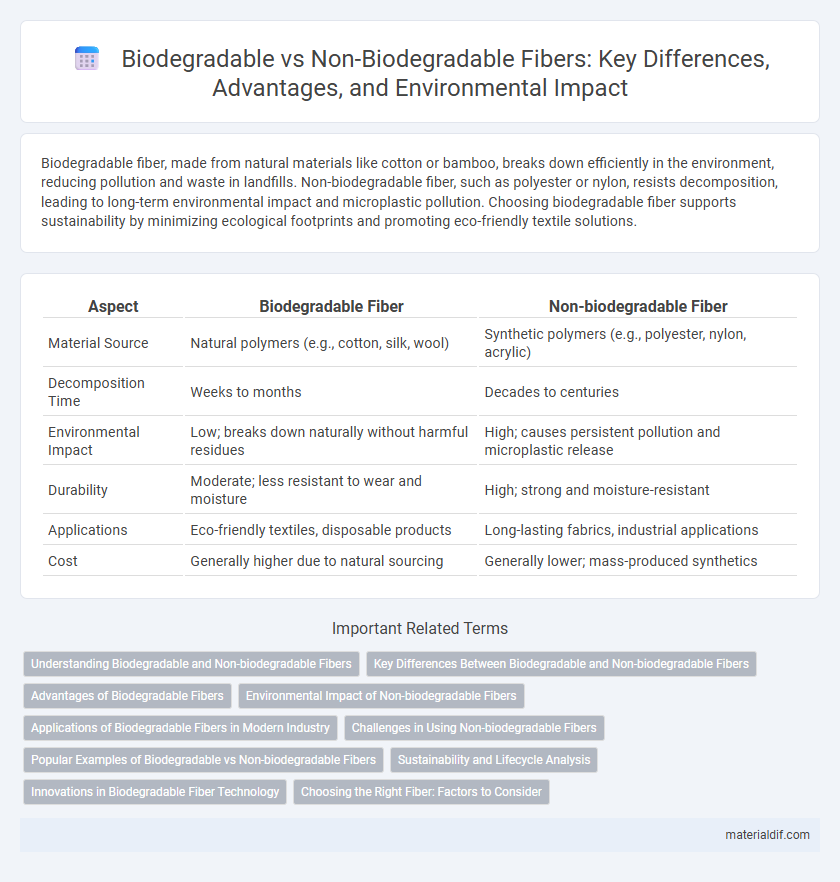Biodegradable fiber, made from natural materials like cotton or bamboo, breaks down efficiently in the environment, reducing pollution and waste in landfills. Non-biodegradable fiber, such as polyester or nylon, resists decomposition, leading to long-term environmental impact and microplastic pollution. Choosing biodegradable fiber supports sustainability by minimizing ecological footprints and promoting eco-friendly textile solutions.
Table of Comparison
| Aspect | Biodegradable Fiber | Non-biodegradable Fiber |
|---|---|---|
| Material Source | Natural polymers (e.g., cotton, silk, wool) | Synthetic polymers (e.g., polyester, nylon, acrylic) |
| Decomposition Time | Weeks to months | Decades to centuries |
| Environmental Impact | Low; breaks down naturally without harmful residues | High; causes persistent pollution and microplastic release |
| Durability | Moderate; less resistant to wear and moisture | High; strong and moisture-resistant |
| Applications | Eco-friendly textiles, disposable products | Long-lasting fabrics, industrial applications |
| Cost | Generally higher due to natural sourcing | Generally lower; mass-produced synthetics |
Understanding Biodegradable and Non-biodegradable Fibers
Biodegradable fibers, derived from natural sources like cotton, wool, and silk, break down efficiently in the environment through microbial activity, reducing long-term pollution. Non-biodegradable fibers, primarily synthetic materials such as polyester, nylon, and acrylic, persist in ecosystems for decades, contributing to plastic waste accumulation and microplastic pollution. Understanding the chemical composition and environmental impact of these fibers is crucial for sustainable textile production and waste management strategies.
Key Differences Between Biodegradable and Non-biodegradable Fibers
Biodegradable fibers, derived from natural sources such as cotton, wool, and silk, decompose quickly through microbial activity, reducing environmental impact and waste accumulation. Non-biodegradable fibers, including polyester, nylon, and acrylic, resist natural degradation processes, leading to persistent pollution and microplastic release in ecosystems. The key differences lie in their chemical composition, environmental footprint, and end-of-life disposal compatibility with sustainable waste management practices.
Advantages of Biodegradable Fibers
Biodegradable fibers decompose naturally in the environment, significantly reducing plastic pollution and landfill waste compared to non-biodegradable fibers. These fibers, often derived from natural sources like cotton, hemp, and bamboo, contribute to sustainable textile production by minimizing ecological impact and promoting soil health during decomposition. Enhanced moisture absorption and breathability are additional benefits, making biodegradable fibers preferable for eco-friendly clothing and packaging solutions.
Environmental Impact of Non-biodegradable Fibers
Non-biodegradable fibers such as polyester, nylon, and acrylic significantly contribute to environmental pollution due to their persistence in ecosystems and resistance to natural degradation processes. These synthetic fibers release microplastics into oceans and soil, harming marine life and entering the food chain, which exacerbates ecological and human health risks. Their production also involves high energy consumption and reliance on fossil fuels, further increasing carbon footprints and environmental degradation.
Applications of Biodegradable Fibers in Modern Industry
Biodegradable fibers, derived from natural sources like cellulose, silk, and polylactic acid (PLA), are extensively used in medical sutures, eco-friendly packaging, and textile manufacturing for sustainable fashion. Their ability to decompose naturally reduces environmental impact, making them ideal for agricultural mulch films and disposable hygiene products. Industries increasingly adopt biodegradable fibers to meet regulatory demands and consumer preference for green alternatives, promoting circular economy principles.
Challenges in Using Non-biodegradable Fibers
Non-biodegradable fibers, such as polyester and nylon, pose significant environmental challenges due to their persistence in ecosystems, leading to microplastic pollution and long-term waste accumulation. Their resistance to natural degradation processes increases landfill volumes and contributes to soil and water contamination. Disposal and recycling of these synthetic fibers remain complex and costly, intensifying the environmental footprint of textile industries.
Popular Examples of Biodegradable vs Non-biodegradable Fibers
Popular biodegradable fibers include cotton, wool, silk, and hemp, which naturally decompose and reduce environmental impact. Non-biodegradable fibers such as polyester, nylon, and acrylic are synthetic, derived from petrochemicals, and persist in the environment for hundreds of years. The choice between biodegradable and non-biodegradable fibers significantly affects sustainability in textile production and waste management.
Sustainability and Lifecycle Analysis
Biodegradable fibers, derived from natural sources like cotton, hemp, or PLA, decompose efficiently in the environment, reducing landfill waste and lowering carbon footprints compared to non-biodegradable synthetic fibers such as polyester and nylon, which persist for decades. Lifecycle analysis reveals biodegradable fibers typically exhibit lower environmental impacts in stages including raw material extraction, manufacturing, and end-of-life disposal, supporting circular economy models and sustainable textile production. Non-biodegradable fibers contribute significantly to microplastic pollution and resource depletion throughout their lifecycle, highlighting the importance of biodegradable alternatives for mitigating environmental harm in the fiber industry.
Innovations in Biodegradable Fiber Technology
Innovations in biodegradable fiber technology have led to the development of materials such as polylactic acid (PLA) and polyhydroxyalkanoates (PHA), which offer eco-friendly alternatives to traditional synthetic fibers like polyester and nylon. Recent advancements incorporate enhanced mechanical properties and faster decomposition rates without compromising durability, making them ideal for textiles, packaging, and agricultural applications. Research into enzyme-triggered degradation and blending biodegradable fibers with natural polymers further improves performance, reducing environmental impact and supporting sustainable textile production.
Choosing the Right Fiber: Factors to Consider
Choosing the right fiber depends on environmental impact, durability, and end-use application. Biodegradable fibers such as cotton and jute decompose naturally, reducing landfill waste and pollution, making them ideal for eco-conscious products. Non-biodegradable fibers like polyester offer superior strength and longevity but pose environmental challenges due to their persistence and microplastic release.
Biodegradable Fiber vs Non-biodegradable Fiber Infographic

 materialdif.com
materialdif.com